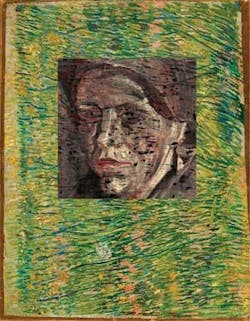FORENSIC IMAGING: Lost Vincent van Gogh painting mapped using x-ray fluorescence technique

Scientists have discovered that Vincent van Gogh’s oil-on-canvas painting, Patch of Grass (1887), is hiding a lost portrait of a woman’s face, according to art historian Joris Dik at the Delft University of Technology (Delft, The Netherlands). Dik and an international team of scientists and art experts revealed the details of the face using synchrotron-radiation-based x-ray fluorescence (XRF) elemental mapping, a new way to perform nondestructive imaging of hidden paint layers.1
As an artist, van Gogh was known to frequently recycle his own canvases; art historians estimate that approximately one third of his existing works of art cover up earlier paintings. But prior attempts to image the art underneath his existing paintings did not reveal much detail. Conventional x-ray radiography previously hinted at the vague shape of a head hiding behind Patch of Grass, but most of the details were invisible. The old x-ray radiography technique, which obtained colorless images via absorption contrast, could not discern paint layers independent of each other, nor was it sensitive to individual elements in the paint pigments.
Visit to Beamline L
To analyze the painting underneath the painting, the team transported Patch of Grass from the Krö ller-Müller Museum (Otterlo, The Netherlands) to the “Beamline L” laboratory at the Deutsches Elektronen-Synchrotron (Hamburg, Germany). The Beamline L micro-x-ray fluorescence (µ-XRF) station enables polychromatic analysis at energies between 5 and 80 keV with a spot-size resolution range from microns to millimeters. Using Beamline L, a pencil-thin beam of quasi-monochromatic synchrotron radiation measuring 0.5 × 0.5 mm was directed onto the center of the canvas. The beam scanned an area of 17.5 × 17.5 cm with an energy of 38.5 keV over the course of a two-day period to obtain fluorescence spectra of the various layers of paint in much less time than previous methods. This enabled the mapping of the distribution of individual elements used in the paint, which enabled the detailed image of the face to emerge (see figure).
Antimony (Sb) emerged as the most dominant element within the hidden layer, which is associated with light-colored red and yellow highlights, followed by mercury (Hg), associated with vermilion (the red component of pinkish flesh tones). A homogenous layer of lead (Pb) was attributed to a whitish primer between the original and existing painting. After assigning color to each element, a reconstructed image revealed brushstrokes and the details of the eyes, nose, mouth, and chin of a woman with a covered head, striking in its similarity to other paintings by van Gogh. The hidden face dovetails with a series of paintings van Gogh created in 1884-85 (more than one are called simply, Head of a Woman), depicting portraits of provincial Dutch peasants.
Point measurements of the flesh tones in similar Head of a Woman van Gogh paintings from the period conducted with a portable XRF unit confirmed the presence of Sb, Hg, and Pb, along with carbon, iron, and manganese, elements used to impart the dark tone of van Gogh’s characteristic palette.
REFERENCES
- J. Dik et al., Anal. Chem. 80(16), 6436 (Aug. 15, 2008).
About the Author
Valerie Coffey-Rosich
Contributing Editor
Valerie Coffey-Rosich is a freelance science and technology writer and editor and a contributing editor for Laser Focus World; she previously served as an Associate Technical Editor (2000-2003) and a Senior Technical Editor (2007-2008) for Laser Focus World.
Valerie holds a BS in physics from the University of Nevada, Reno, and an MA in astronomy from Boston University. She specializes in editing and writing about optics, photonics, astronomy, and physics in academic, reference, and business-to-business publications. In addition to Laser Focus World, her work has appeared online and in print for clients such as the American Institute of Physics, American Heritage Dictionary, BioPhotonics, Encyclopedia Britannica, EuroPhotonics, the Optical Society of America, Photonics Focus, Photonics Spectra, Sky & Telescope, and many others. She is based in Palm Springs, California.
